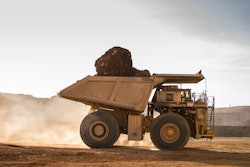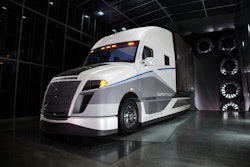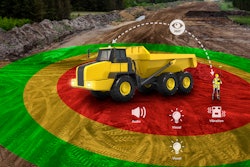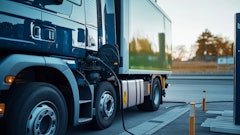
If Work Truck Week 2022 had to be summed up in one word, well, it’s electric.
While the Chevy Silverado EV and Ford F-150 Lightning dominated headlines from Indianapolis, it was the applications for larger electric vehicles (EV) that could have the most impact for years to come. NTEA, the Association for the Work Truck Industry, says they had over a dozen EV launches this year.
Tom Wallace, sales manager for Iowa Mold Tooling Co., Inc. (IMT), cites the EV trend as the most important one he’s seen in his 15-year career.
“Electrification is the future,” Wallace says. “There have been some trends that made a big impact, namely the size of equipment getting bigger starting with Caterpillar and Komatsu, and we’ve had to grow to be able to work alongside. As a long-staying impact, I would say electrification will top that list, once it’s adopted and trusted.”
The size of the vehicles is itself a hurdle to adoption, explains Jacob Larimore, senior director of business development and strategy for EAVX.
“People are excited to see there are EVs here now today, and they’re not small ones either,” Larimore says. “As you go up in class, the problems you have to solve with electrification are amplified.”
How Soon Can the Transformation Happen?
IMT’s prototype electro-hydraulic telescopic crane and compressor package powered by Vanair’s EPEQ power system and ELiMENT batteries allows the user to power the crane even while the vehicle is off and without a traditional PTO and pump setup. The first-to-industry solution allows the user to either buy new and go fully electric or retrofit an existing diesel truck, Wallace says.
EAVX focused on collaborations with JB Poindexter sister business units Reading Truck and Morgan Truck Body, highlighting partnerships with electric chassis manufacturers including Zeus Electric Chassis, Lion Electric and International. The concept vehicles also highlighted VX Control technology upfitted by EAVX.
Where the Transformation Begins
EAVX COO Mark Hope sees the greatest opportunities for electrification to take off in the next five years in last-mile package deliveries, which have a conducive drive cycle, telecom/utility trucks where electric is the standard and refrigerated/grocery delivery vehicles that have the most to be saved because of continuous operation. For off-highway vehicles, Hope predicts full electrification to be elusive but targeted applications to have an impact.
“You have to look at solutions that don’t turn the design upside down, just how we get power to them,” Hope says.
Municipal uses – where there’s a requirement for noise reduction and lower emissions – and rental companies are also at the leading edge of adoption, says Wallace.
What Stands in the Way?
EV experts across Work Truck Week acknowledged significant hurdles in the near-term for electrification to take off.
Infrastructure. “Infrastructure is the first thing that jumps out,” Hope says. “You have to be able to charge all of these vehicles. The more you put out there the more burden you put on the grid and the more burden you put on the fleet.”
Supply chain. Materials supply, battery supply, battery components like lithium and cobalt—the supply chain disruption of the past two years continues to affect electrification. Wallace, however, points out that supply challenges are also opportunities.
“We all know that chassis are very hard to find these days,” he says. “If you have a truck that’s five years old and has low mileage, and you need to work toward a more efficient system today, [a retrofit solution like IMT and Vanair’s] is the way to do it.”
Adds Larimore: “There will be big improvement by the end of 2022.”
Battery cost, size and charge times. Hope said that beyond supply chain, initial barriers around batteries are starting to fall.
“As more OEMs move into electrification, we’ll start to get to scale, and you’ll see costs decrease. You’ll see battery progression as well. Those trends are real,” Hope explains. “The more units get into the field, the more they’ll put R&D back into it.”
“We’re looking at a slimmer profile battery that is easier to set up against a bulkhead wall and not as heavy; we’re always trying to get weight out of a truck,” Wallace agrees.
Driving the Electrification Trend Forward
Electrification mandates alone can’t lead to wide-scale adoption, experts agree. But other factors that can: Rising oil prices and tighter margins.
“There will always be a little pushback because it’s new and it’s a change,” says Wallace. “But our customers in our markets are really trying to understand [electrification]. One thing customers love is a way to save money.”



















